Immigration Clampdown: the Threat to Brooklyn’s Economy
The borough's boom has been partly fueled by new workers and entrepreneurs. What happens when that's choked off?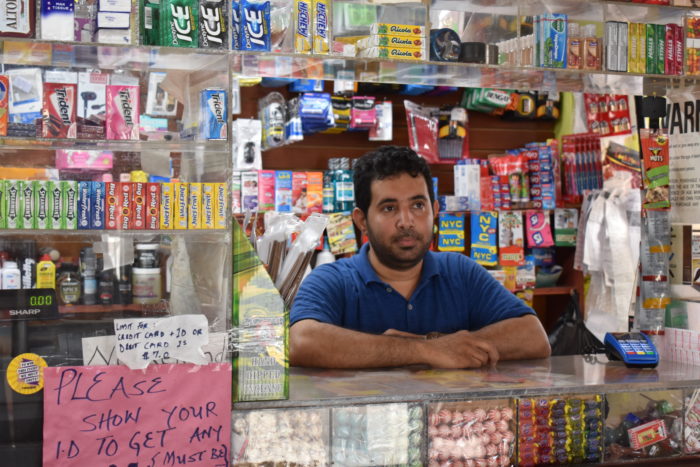
Jameel Zaid, co-owner of a bodega in East Flatbush, sends up to $2,000 a month to his wife and children, stranded overseas by the travel ban (Photo by Graison Dangor)
When Zaid Nagi started his first business in 2005, he had just $5,000 in cash and had to borrow $20,000 more. Today Nagi, who immigrated to the U.S. in 1994 as a teenager, owns five cell phone stores and a bodega in the city.
He owes much of that success to fellow Yemenis who have immigrated to the U.S. Nagi, 36, has hired about 15 people from Yemen who arrived through the Diversity Immigrant Visa program, a lottery that allows people from countries with few migrants to the U.S. apply for a lottery to enter the country.
Diversity Visa winners make good managers, said Nagi. They tend to be well educated and are at the beginning of their careers, he said. It gives him the best of both worlds: skilled employees willing to work for less than someone born in the U.S. who has the same qualifications. After a couple of years working as employees, it is not uncommon for managers to leave and start their own businesses, some of which Nagi has invested in.
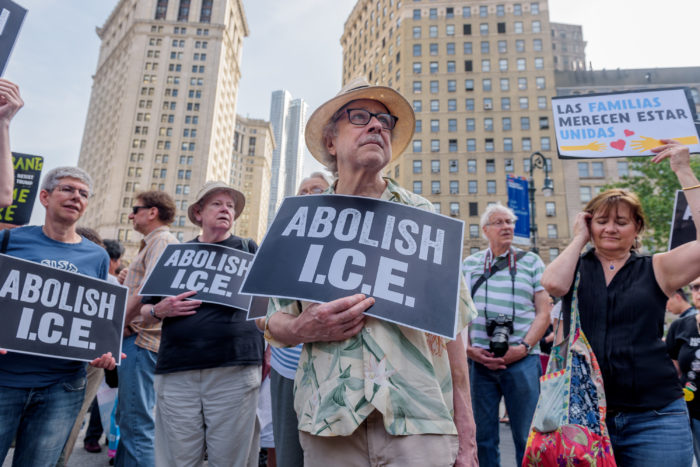
Last month, immigrants and their allies led a walk in Foley Square in Manhattan, many of them calling for ICE to be abolished (Photo ©Erik Mcgregor/Pacific Press via ZUMA Wire)
Nagi, who lives in Yonkers, helps entrepreneurs as the vice president of the Brooklyn-based Yemeni American Merchants Association, a group which formed out of a bodega strike he helped organize in February 2017, in which 1,000 bodegas closed in protest of the Trump Administration’s newly issued ban on travel from several predominantly Muslim countries.
Now that the Supreme Court has affirmed the ban, Diversity Visas are worthless to people from banned countries. A stream of opportunity that allowed Nagi to build several businesses–and help spin off several more–has run dry. “It’s a big, big loss,” he said.
The travel ban is just one prong of the Trump Administration’s campaign to limit immigration, legal or otherwise. The administration is seeking to end the Deferred Action for Childhood Arrivals program, or DACA, the program that protects about 800,000 immigrants brought into the U.S. as children. It has staged massive raids of undocumented workers. It is choking the supply of skilled-worker visas. It has vastly increased arrests of undocumented immigrants without criminal records. In New York City, arrests by Immigration and Customs Enforcement (ICE) have more than tripled.
This week BuzzFeed News published a list of ways in which the administration has sought to keep out immigrants; its tally counted 18 actions including suspending legal assistance and blocking asylum for victims of domestic abuse and gang violence.
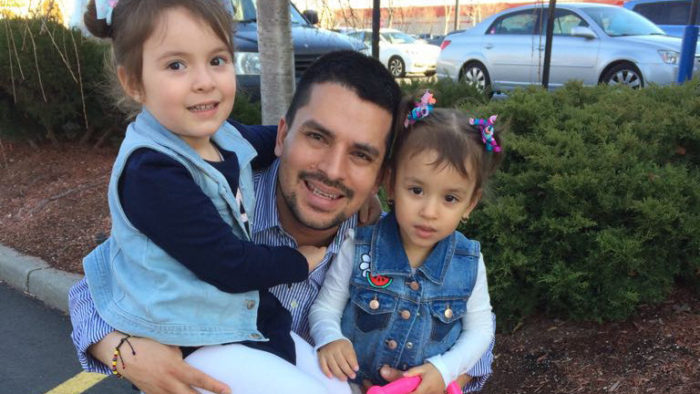
Pablo Villavicencio, the deliveryman detained by ICE, with his two daughters in a photo provided by his wife (Photo courtesy of AP)
The ICE crackdown hit close to home for Brooklyn. In June, Pablo Villavicencio, a Long Island man delivering a catering order to Fort Hamilton, the military base in Bay Ridge, was arrested for entering the country illegally a decade earlier. Last week, Concepción and Margarito Silva, a Brooklyn couple in the U.S. for more than two decades, were arrested when visiting their daughter at an army base in upstate New York. Update: on July 24, federal judge Paul Crotty ordered Villavicencio released, ruling that he could remain free while pursuing legal status. “He has no criminal history. He has paid his taxes. And he has worked diligently to provide for his family,” the judge wrote.
All told, the multifaceted crackdown on immigration is likely to harm the economy of Brooklyn more than some other places, since one of the borough’s drivers of growth has its inflow of new workers and entrepreneurs. The impact of new immigrants is “immensely positive,” says Edward Rogoff, a professor and former dean at LIU Brooklyn’s business school. “Every study ever done shows immigrants contribute to the economy. It’s obvious to anyone in New York,” said Rogoff, whose grandparents immigrated to the U.S. from Russia.
Counting the Cost
In Brooklyn, more than 36% of residents in the borough were born in another country, a rate similar to the rest of New York City and nearly triple the U.S. overall. They have an outsized role in the borough’s economy, representing 48% of the borough’s work force and 57% of its self-employed entrepreneurs, according to a June report by the state comptroller. In New York State, undocumented residents pay $1.1 billion in state and local taxes every year.
While it’s too early to quantify the impact of the immigration crackdown, anecdotally a picture forms of thwarted dreams. Nagi, for example, used to own more cell phone stores. But after the Muslim ban ended the Diversity Visa for Yemenis, Nagi couldn’t find a qualified manager for one of his locations in Brooklyn. He settled for a manager who he suspected, correctly, could not handle the job. The store kept losing money, and several months ago Nagi shut it down.
The travel ban was not the only factor, he said, but it was a major one. He expects it to keep having an impact. Losing his pipeline of managers, he said, means “we have to slow growth.“
The ban has had another side effect for Brooklyn immigrants, which is the burdensome cost of supporting relatives stranded back home or in third countries, many having fled the Saudi Arabian-led war against an insurgent government in Yemen.
Nagi’s own mother and grandmother have lived in Jordan for close to three years while waiting for a decision on a U.S. visa. His mother just learned about hers. “Three days ago,” he said, “she received her refusal.” Nagi, his brothers and his uncle have sent about $50,000 overseas to support their relatives.
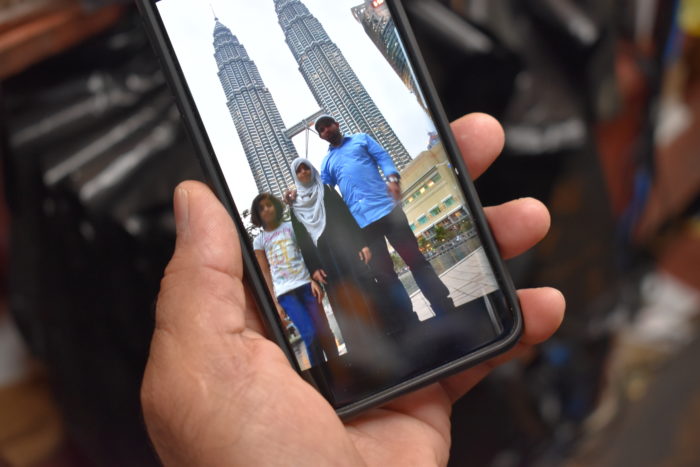
Jameel Zaid shows a cellphone photo of him with his two daughters on a visit to Malaysia, where the rest of his family is waiting in hopes of getting a U.S. visa (Photo by Graison Dangor)
Their savings could otherwise be going towards a down payment on a house, starting a business, sending a child to college, or to other local purchases that bolster the economy. Abdulsamad Elfgeeh, a naturalized U.S. citizen who lives in Sunset Park, spends $3,000 a month to support his wife and four school-age children who, after fleeing Yemen, have been waiting in Malaysia in hopes of getting a U.S. visa. Elfgeeh, 39, now owes $8,000 on his credit card and at least $13,000 to relatives.
After spending much of his youth traveling back and forth to the U.S. from Yemen for work, Elfgeeh settled down in his native country with his wife and kids. He started an auto-parts business in 2010. The next year, a revolution and civil war broke out, which by 2015 included a bombing campaign by a Saudi-led coalition. Immigration to the U.S. from Yemen more than quadrupled in 2016.
Late last year, the bombings became too much for Elfgeeh’s family, which fled to Malaysia. Since Elfgeeh and his wife did not have permission to work there, Elfgeeh returned to the U.S. to find employment. He plans to start driving for Uber as many hours a day as he can, holding out hope that he can pay for a lawyer to help get visas for his family.
If his family’s case requires getting a waiver from the Muslim ban, his chances are slim. From December through May, just 2% of 33,000 applications were approved, according to a State Department letter sent to U.S. Senator Chris Van Hollen in June.
“We face two things,” he said, holding up both hands. “Ban here,” he said, holding up one hand, and on the other, “war here. We’re in the middle. We don’t [want] anyone to face what we face.”
Other Brooklyn immigrants tell strikingly similar stories. Jameel Zaid, 34, a Yemeni-American who co-owns a bodega in East Flatbush, sends up to $2,000 a month to his wife and two daughters, also stranded in Malaysia after fleeing Yemen. His visited them in December, but before that hadn’t seen them in more than three years.
A Worker Shortage at Hand?
The seizures by ICE have a more immediate and direct effect on the economy by removing people from the workforce–and breadwinners from their families. ICE’s Enforcement and Removal Operations made 2,576 criminal and non-criminal arrests in its New York City territory from October 2016 through September 2017, the most recent data available.
Deliveryman Pablo Villavicencio, who was jailed by ICE in New Jersey after his arrest, is married with two daughters. Governor Cuomo has written ICE a letter demanding his release. “This human rights abuse is just the latest in a frightening pattern of disgraceful and, in many cases, illegal tactics used by ICE,” Cuomo write. Villavicencio’s next court date is July 24.
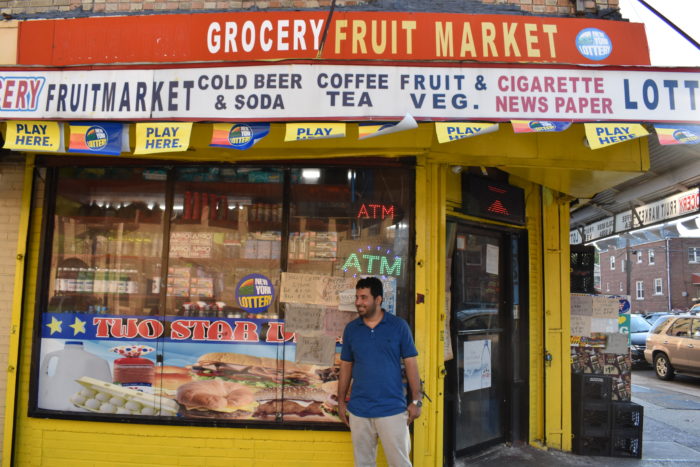
Zaid outside the bodega he co-owns in East Flatbush (Photo by Graison Dangor)
Many employers in Brooklyn are worried what could happen if members of their staff start getting deported. A spokesperson for City Council Member Carlos Menchaca, whose District 38 includes immigrant-rich Sunset Park, said that some business owners were making deliveries in place of employees out of concern they might be grabbed by ICE.
Anxiety surrounds the other immigration-crackdown measures as well. In a survey of Brooklyn Chamber of Commerce members taken in January, four in 10 respondents said the elimination of the DACA would negatively affect their workforce. The borough is home to an estimated 22,000 DACA-covered residents, many of whom help support their families.
The chamber’s agenda includes defending the availability of H-1B visas, the largest temporary worker program in the U.S. and a key way for firms to get skilled workers. The Trump Administration has made the visas harder to get, which could hit the New York City area hard. From 2010 to 2016, a quarter million H-1B visas were given to workers employed in the region, which is home to three in 10 holders of H-1B visas nationwide. “They keep changing the rules,” said Cheryl David, an immigration lawyer in New York. Faced with months of uncertainty of a potential employee’s status, she said, “employers are not going to wait. Employers now are reluctant to sponsor anyone.”
Meanwhile, David said, these highly skilled workers aren’t going to wait either. They can go to Canada or Europe instead. Efforts to build up the borough’s tech hubs in the Brooklyn Navy Yard, Industry City and Brooklyn Army Terminal could suffer from a shortage of skilled professionals to work there. “People aren’t going to want to come here,” said David, “and we’re going to lose the best and brightest.”
What Can Be Done
New York has mounted a spirited local resistance to the Trump Administration crackdown. There is evidence, for example, that city-sanctuary policies may have prevented ICE from arresting more undocumented workers.
Mayor de Blasio’s administration has committed $30 million to immigration legal services, according to the Mayor’s Office of Immigration Affairs. Residents can call “311” to ask for ActionNYC, its legal-help program. They can also call 311 to file a human-rights complaint if they have witnessed harassment or discrimination.
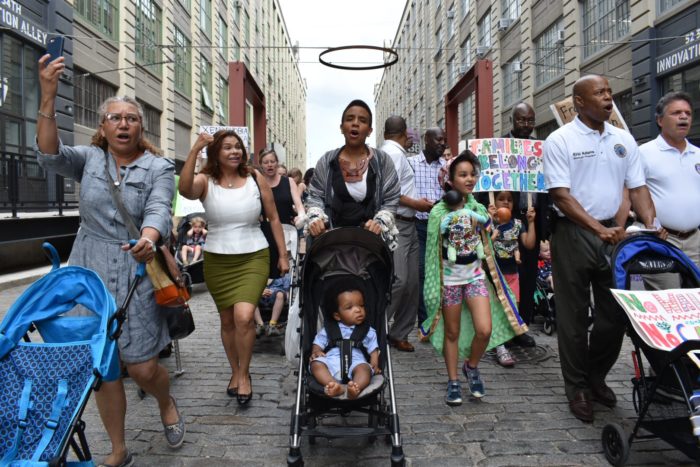
A “stroller march” drew hundreds last month in Sunset Park, including City Council Member Laurie Cumbo, center, and Borough President Eric Adams, at right (Photo by Graison Dangor)
The most visible of the city’s policies is its municipal ID card, which was designed in part to give undocumented residents an official way to prove their identity. It is recognized across city government, including the police department, but its limitation outside the city became clear with the arrest of Villavicencio, who was apprehended on federal territory. His IDNYC card was not accepted by the military police officer controlling entry to Fort Hamilton. The background check that took place afterward revealed his outstanding order of deportation from 2010, according to the New York Times.
Had Villavicencio held a New York State driver’s license, he would have been able to pass into the base without issue. Legislation is pending in Albany that would allow undocumented residents to get licenses, but Brooklyn Borough President Eric Adams has called on Cuomo to sign an executive order authorizing them now. There is precedent for acting alone, Adams wrote in an op-ed with Javier Valdés of Make the Road New York, an immigrant-advocacy group. Since 2001, the undocumented residents of New York have had their ability to get a driver’s license rescinded (by Governor Pataki), restored (Governor Spitzer), then rescinded again (also Spitzer, bowing to pressure).
Raising public awareness has been another tactic. In June, Adams and other elected officials led a march on a federal jail in Sunset Park, drawing hundreds of people for a “stroller march” in protest of the President’s immigration policies, especially his now-discontinued policy of separating families at the border. The stroller Adams pushed carried a sign bearing the words “No Walls, No Cages.”










